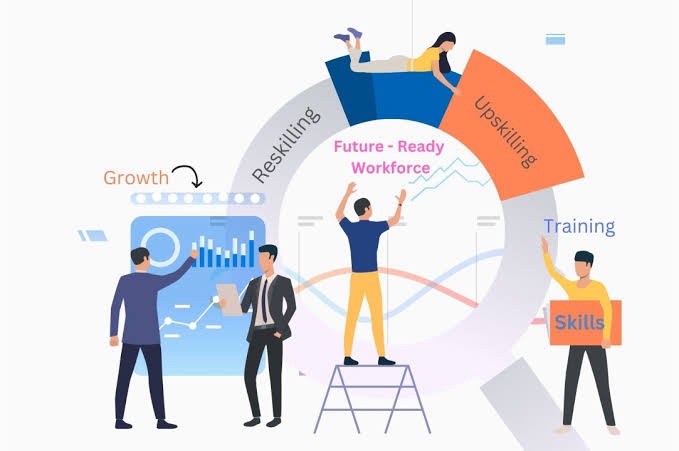Technology Aur Employment: Kaise Technology Ne Badla Job Markets Aur Employment Patterns?”

Introduction
Aaj ke digital yug mein, technology ne job markets aur employment patterns ko dramatically transform kar diya hai. Yeh transformation kaise hua hai, aur yeh dono positive aur negative effects kya hain? Is blog post mein hum explore karenge technology ke impact ko, aur yeh bhi dekhenge ki individuals aur organizations kaise in changes ke saath adapt kar sakte hain.
1. Automation Aur Job Displacement
1.1. Automation In Various Sectors
Technology, khas karke automation aur robotics, ne kai industries mein efficiency aur productivity ko improve kiya hai. Lekin yeh bhi sach hai ki yeh kuch jobs ko displace kar raha hai.
- Manufacturing: Robots aur automated systems repetitive tasks ko handle karte hain, jisse manual labor ki zaroorat kam ho gayi hai.
- Retail: Self-checkout kiosks aur online shopping platforms traditional retail workers ki demand ko decrease kar rahe hain.
- Finance: Algorithms aur software data analysis aur transaction processing jaise tasks handle karte hain, jisse finance aur accounting roles impact ho rahe hain.
1.2. Reskilling Aur Upskilling
Jab automation kuch jobs ko replace kar raha hai, tab reskilling aur upskilling ki zaroorat badh gayi hai. Workers ko naye skills acquire karne ki zaroorat hai taaki woh job market mein relevant rah sakein. Ismein naye technologies ko operate aur manage karna shamil hai, ya aise roles mein transition karna jo human creativity, problem-solving, aur emotional intelligence require karte hain.
2. Naye Job Roles Ki Creation
2.1. Technology-Driven Jobs
Technology ne naye job opportunities create kiye hain jo pehle exist nahi karti thi. AI, cybersecurity, data science, aur digital marketing jaise fields mein roles high demand mein hain. Yeh positions specialized skills aur education ko reflect karte hain:
- AI Aur Machine Learning: AI researchers, data scientists, aur machine learning engineers AI technologies ko develop aur implement karne ke liye crucial hain.
- Cybersecurity: Cyber threats ke rise ke saath, cybersecurity professionals ki demand badh gayi hai jo systems aur data ko protect kar sakein.
- Data Analysis: Data analysts aur data scientists business insights aur decision-making ke liye big data ko interpret aur leverage karte hain.
2.2. Gig Economy Aur Freelancing
Technology ne gig economy ko bhi janam diya hai, jahan individuals freelancers ya independent contractors ke roop mein kaam karte hain. Platforms like Uber, Upwork, aur Fiverr logon ko flexible basis par services offer karne ke opportunities dete hain.
- Flexibility: Freelancers aur gig workers ko apne schedules aur work locations par control milta hai.
- Diverse Opportunities: Gig economy graphic design se lekar writing aur delivery tak, kai types ke work ke opportunities provide karta hai.
3. Remote Work Aur Virtual Collaboration
3.1. Remote Work Ka Growth
Communication aur collaboration technologies ke advancements ne remote work ko feasible banaya hai. Video conferencing, project management software, aur cloud storage jese tools employees ko virtually kahin bhi work karne ki suvidha dete hain, jo traditional office environments ko transform kar raha hai.
- Benefits: Remote work flexibility, commuting time ko reduce karna, aur better work-life balance provide karta hai.
- Challenges: Remote work productivity maintain karna, remote teams ko manage karna, aur effective communication ensure karna challenging ho sakta hai.
3.2. Virtual Collaboration Tools
Virtual collaboration tools ne geographical boundaries ke across teamwork aur project management ko facilitate kiya hai. Tools like Slack, Microsoft Teams, aur Trello tasks coordinate karne, information share karne, aur projects pe collaborate karne ke liye essential ban gaye hain.
4. Workforce Diversity Aur Inclusion Par Impact
4.1. Expanding Opportunities
Technology ke through underrepresented groups ke liye job opportunities expand ho sakti hain, remote work aur freelance opportunities ke through. Yeh employment gaps ko bridge karne aur inclusive work environments create karne mein madad kar sakta hai.
4.2. Bias Ko Address Karna
Lekin, technology bhi existing biases ko perpetuate kar sakta hai agar thoughtfully implement na kiya jaye. For example, hiring processes mein use hone wale algorithms kuch demographics ko unintentionally favor kar sakte hain. Fair aur equitable employment practices ensure karne ke liye biases ko address karna zaroori hai.
5. Technological Changes Ko Adapt Karna
5.1. Lifelong Learning
Job market mein competitive rahne ke liye individuals ko lifelong learning ko embrace karna hoga. Continuous education, professional development, aur adaptability key hain technology ke advancements aur job requirements ke changes ke saath relevant rehne ke liye.
5.2. Organizational Adaptation
Organizations ko bhi technological changes ke saath adapt karna padega. Employee training mein investment, innovation ka culture foster karna, aur naye technologies ko business goals ke saath align karna zaroori hai. Strategic planning aur change management bhi essential hain.
5.3. Policy Aur Regulation
Policymakers ko technology ke employment par impacts address karne ke liye policies implement karni chahiye jo workforce development ko support karein, workers’ rights ko protect karein, aur equitable access to opportunities promote karein. Ismein education aur training programs mein investment aur fair labor practices ensure karna shamil hai.
6. Conclusion
Technology ne job markets aur employment ko profoundly impact kiya hai, jo opportunities aur challenges dono ko drive karta hai. Jab automation aur technological advancements job displacement ki wajah ban sakti hain, woh naye roles aur innovation ke opportunities bhi create karti hain. Reskilling, remote work adaptation, aur workforce diversity ko address karke, individuals aur organizations evolving job landscape ko effectively navigate kar sakte hain. Technological trends ke saath informed rehna aur proactive preparation future of work mein thrive karne ke liye key hoga.







 Total views : 6180
Total views : 6180